The Use of Calcium Lactate to Enhance the Durability and Engineering Properties of Bioconcrete
Abstract
:1. Introduction
2. Experimental Work
2.1. Materials
2.2. Preparation of Ureolytic Bacteria and Calcium Lactate
2.3. Concrete Mix Design
2.4. Test Setup and Method
2.4.1. Compressive Strength Test
2.4.2. Splitting Tensile Test
2.4.3. Flexural Strength Test
2.4.4. Water Penetration
2.5. Microstructure Analysis
2.6. Design of Experiment
3. Results and Discussion
3.1. Independent Factors Screening
3.2. Compressive Strength
3.3. Splitting Tensile Strength
3.4. Flexural Strength
3.5. Water Penetration
3.6. Optimization of Concrete Properties via RSM
3.7. SEM Analysis
4. Conclusions
Author Contributions
Funding
Institutional Review Board Statement
Informed Consent Statement
Data Availability Statement
Acknowledgments
Conflicts of Interest
References
- Khaliq, W.; Ehsan, M.B. Crack healing in concrete using various bio influenced self-healing techniques. Constr. Build. Mater. 2016, 102, 349–357. [Google Scholar] [CrossRef]
- Algaifi, H.A.; Bakar, S.A.; Alyousef, R.; Sam, A.R.M.; Ibrahim, M.W.; Shahidan, S.; Ibrahim, M.; Salami, B.A. Bio-inspired self-healing of concrete cracks using new B. pseudomycoides species. J. Mater. Res. Technol. 2021, 12, 967–981. [Google Scholar] [CrossRef]
- Reinhardt, H.-W.; Jooss, M. Permeability and self-healing of cracked concrete as a function of temperature and crack width. Cem. Concr. Res. 2003, 33, 981–985. [Google Scholar] [CrossRef]
- Amziane, S.; Sonebi, M. Overview on Biobased Building Material made with plant aggregate. RILEM Tech. Lett. 2016, 1, 31–38. [Google Scholar] [CrossRef]
- Wang, J. Self-Healing Concrete by Means of Immobilized Carbonate Precipitating Bacteria. Ph.D. Thesis, Ghent University, Ghent, Belgium, 2013. [Google Scholar]
- Wang, J.; Jonkers, H.M.; Boon, N.; De Belie, N. Bacillus sphaericus LMG 22257 is physiologically suitable for self-healing concrete. Appl. Microbiol. Biotechnol. 2017, 101, 5101–5114. [Google Scholar] [CrossRef] [PubMed]
- Siddique, R.; Chahal, N.K. Effect of ureolytic bacteria on concrete properties. Constr. Build. Mater. 2011, 25, 3791–3801. [Google Scholar] [CrossRef]
- Parastegari, N.; Mostofinejad, D.; Poursina, D. Use of bacteria to improve electrical resistivity and chloride penetration of air-entrained concrete. Constr. Build. Mater. 2019, 210, 588–595. [Google Scholar] [CrossRef]
- Karimi, N.; Mostofinejad, D. Bacillus subtilis bacteria used in fiber reinforced concrete and their effects on concrete penetrability. Constr. Build. Mater. 2020, 230, 117051. [Google Scholar] [CrossRef]
- Nguyen, T.H.; Ghorbel, E.; Fares, H.; Cousture, A. Bacterial self-healing of concrete and durability assessment. Cem. Concr. Compos. 2019, 104, 103340. [Google Scholar] [CrossRef]
- Algaifi, H.A.; Bakar, S.A.; Sam, A.R.M.; Abidin, A.R.Z.; Shahir, S.; AL-Towayti, W.A.H. Numerical modeling for crack self-healing concrete by microbial calcium carbonate. Constr. Build. Mater. 2018, 189, 816–824. [Google Scholar] [CrossRef]
- Algaifi, H.A.; Bakar, S.A.; Sam, A.R.M.; Ismail, M.; Abidin, A.R.Z.; Shahir, S.; Altowayti, W.A.H. Insight into the role of microbial calcium carbonate and the factors involved in self-healing concrete. Constr. Build. Mater. 2020, 254, 119258. [Google Scholar] [CrossRef]
- Kumari, C.; Das, B.; Jayabalan, R.; Davis, R.; Sarkar, P. Effect of nonureolytic bacteria on engineering properties of cement mortar. J. Mater. Civ. Eng. 2017, 29, 06016024. [Google Scholar] [CrossRef]
- Ghosh, P.; Mandal, S.; Chattopadhyay, B.; Pal, S. Use of microorganism to improve the strength of cement mortar. Cem. Concr. Res. 2005, 35, 1980–1983. [Google Scholar] [CrossRef]
- Andalib, R.; Abd Majid, M.Z.; Hussin, M.W.; Ponraj, M.; Keyvanfar, A.; Mirza, J.; Lee, H.-S. Optimum concentration of Bacillus megaterium for strengthening structural concrete. Constr. Build. Mater. 2016, 118, 180–193. [Google Scholar] [CrossRef]
- Kunal; Siddique, R.; Rajor, A.; Singh, M. Influence of bacterial-treated cement kiln dust on strength and permeability of concrete. J. Mater. Civ. Eng. 2016, 28, 04016088. [Google Scholar] [CrossRef]
- Priya, T.S.; Ramesh, N.; Agarwal, A.; Bhusnur, S.; Chaudhary, K. Strength and durability characteristics of concrete made by micronized biomass silica and Bacteria-Bacillus sphaericus. Constr. Build. Mater. 2019, 226, 827–838. [Google Scholar] [CrossRef]
- Mondal, S.; Ghosh, A.D. Investigation into the optimal bacterial concentration for compressive strength enhancement of microbial concrete. Constr. Build. Mater. 2018, 183, 202–214. [Google Scholar] [CrossRef]
- Chahal, N.; Siddique, R.; Rajor, A. Influence of bacteria on the compressive strength, water absorption and rapid chloride permeability of fly ash concrete. Constr. Build. Mater. 2012, 28, 351–356. [Google Scholar] [CrossRef]
- Nosouhian, F.; Mostofinejad, D.; Hasheminejad, H. Influence of biodeposition treatment on concrete durability in a sulphate environment. Biosyst. Eng. 2015, 133, 141–152. [Google Scholar] [CrossRef]
- Vijay, K.; Murmu, M. Effect of calcium lactate on compressive strength and self-healing of cracks in microbial concrete. Front. Struct. Civ. Eng. 2019, 13, 515–525. [Google Scholar] [CrossRef]
- Ducasse-Lapeyrusse, J.; Gagné, R.; Lors, C.; Damidot, D. Effect of calcium gluconate, calcium lactate, and urea on the kinetics of self-healing in mortars. Constr. Build. Mater. 2017, 157, 489–497. [Google Scholar] [CrossRef]
- Al-Shaibani, M.M.; Radin Mohamed, R.M.S.; Zin, N.M.; Al-Gheethi, A.; Al-Sahari, M.; El Enshasy, H.A. Enhanced Pharmaceutically Active Compounds Productivity from Streptomyces SUK 25: Optimization, Characterization, Mechanism and Techno-Economic Analysis. Molecules 2021, 26, 2510. [Google Scholar] [CrossRef] [PubMed]
- European Committee for Standardization. Cement. Composition, Specifications and Conformity Criteria for Common Cements; British Standard Institution: London, UK, 2011; BS EN 197-1:2011; pp. 1–197. [Google Scholar]
- Specification for Aggregates from Natural Sources for Concrete; British Standards Institution: London, UK, 1992; BS 882:1992; pp. 1–14.
- Xu, J.; Du, Y.; Jiang, Z.; She, A. Effects of calcium source on biochemical properties of microbial CaCO3 precipitation. Front. Microbiol. 2015, 6, 1366. [Google Scholar] [CrossRef] [PubMed]
- Standard Test Method for Compressive Strength of Cement Mortar; British Standard Institution: London, UK, 2002; B EN 12390:2002; Part-3.
- Testing Hardened Concrete. Tensile Splitting Strength of Test Specimens; British Standard Institution: London, UK, 2009; B EN 12390:2009; Part-6.
- Testing Hardened Concrete. Flexural Strength of Test Specimens; British Standards Institution: London, UK, 2009; B EN 12390:2009; Part-5.
- Testing Hardened Concrete; British Standard Institution: London, UK, 2009; B EN 12390:2009; Part-8.
- Myers, R.H.; Montgomery, D.C.; Anderson-Cook, C. Process and product optimization using designed experiments. Response Surf. Methodol. 2002, 2, 328–335. [Google Scholar]
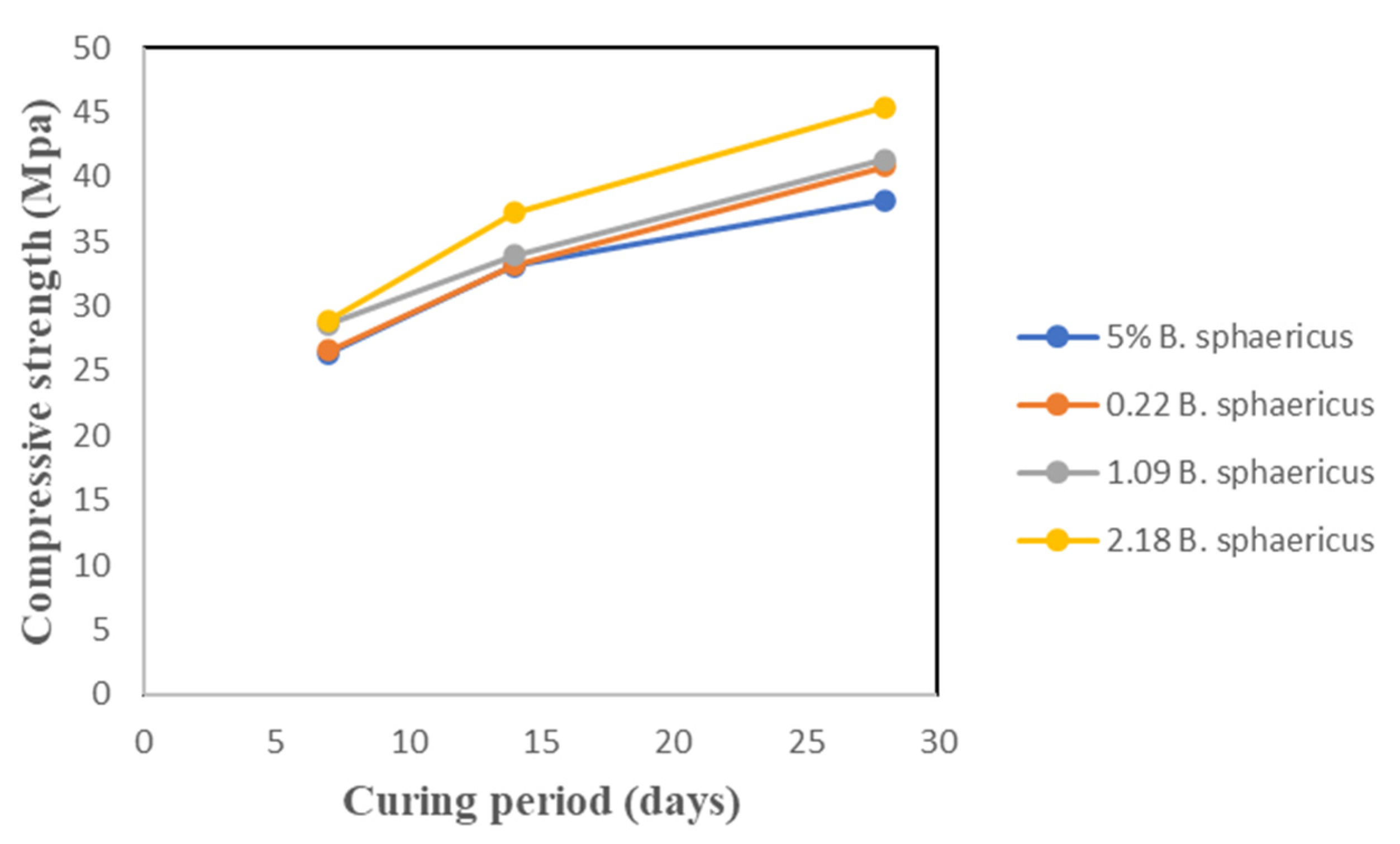
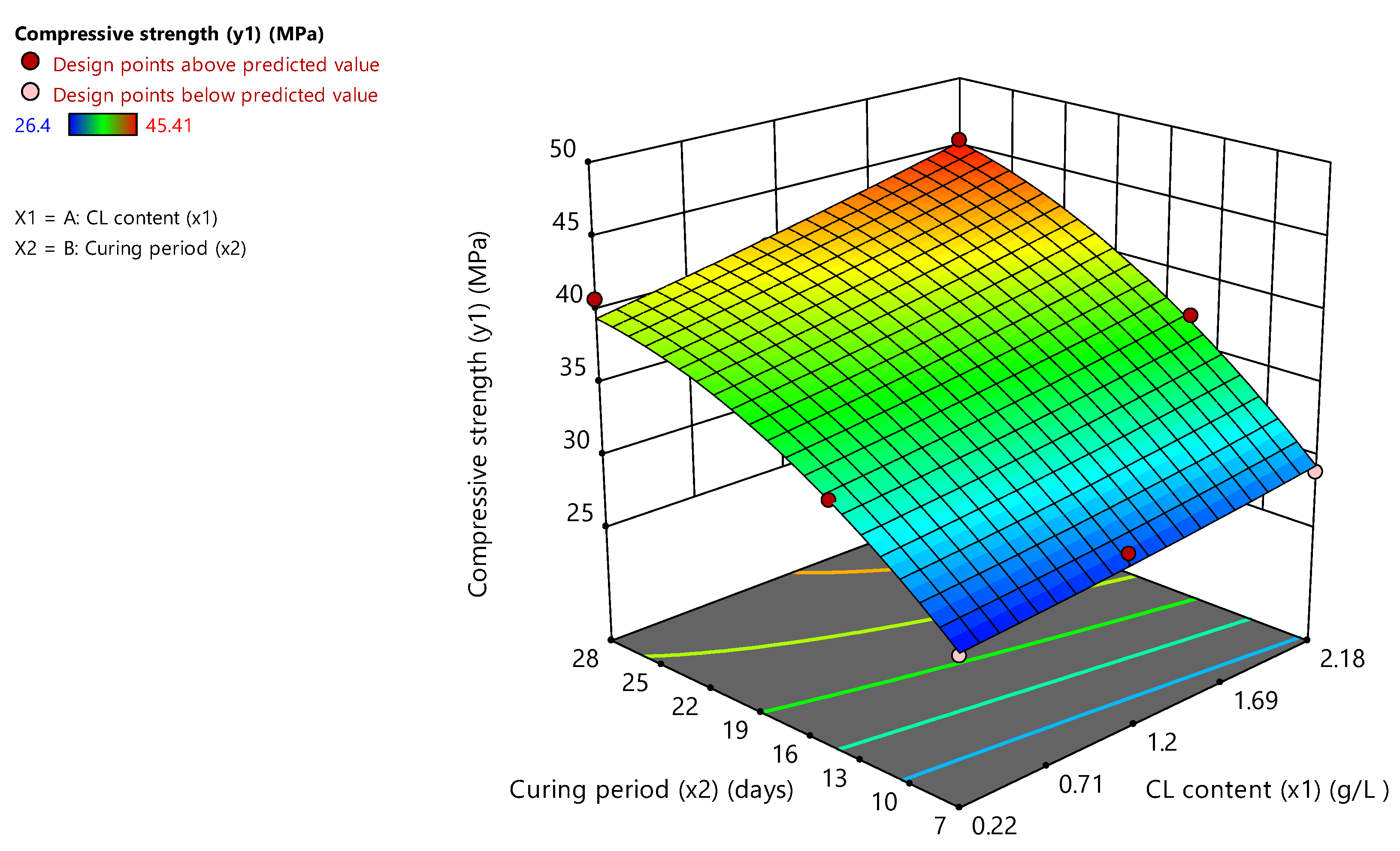
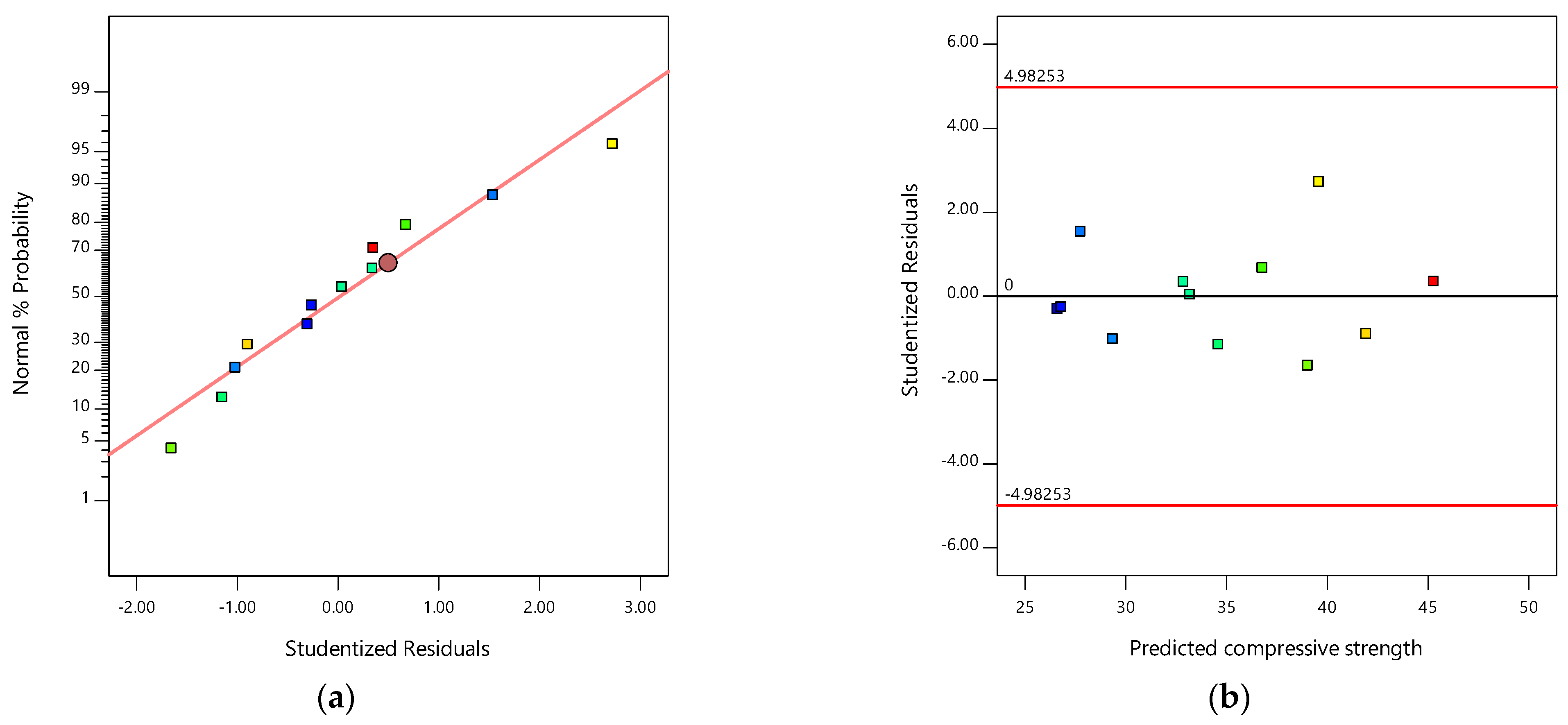

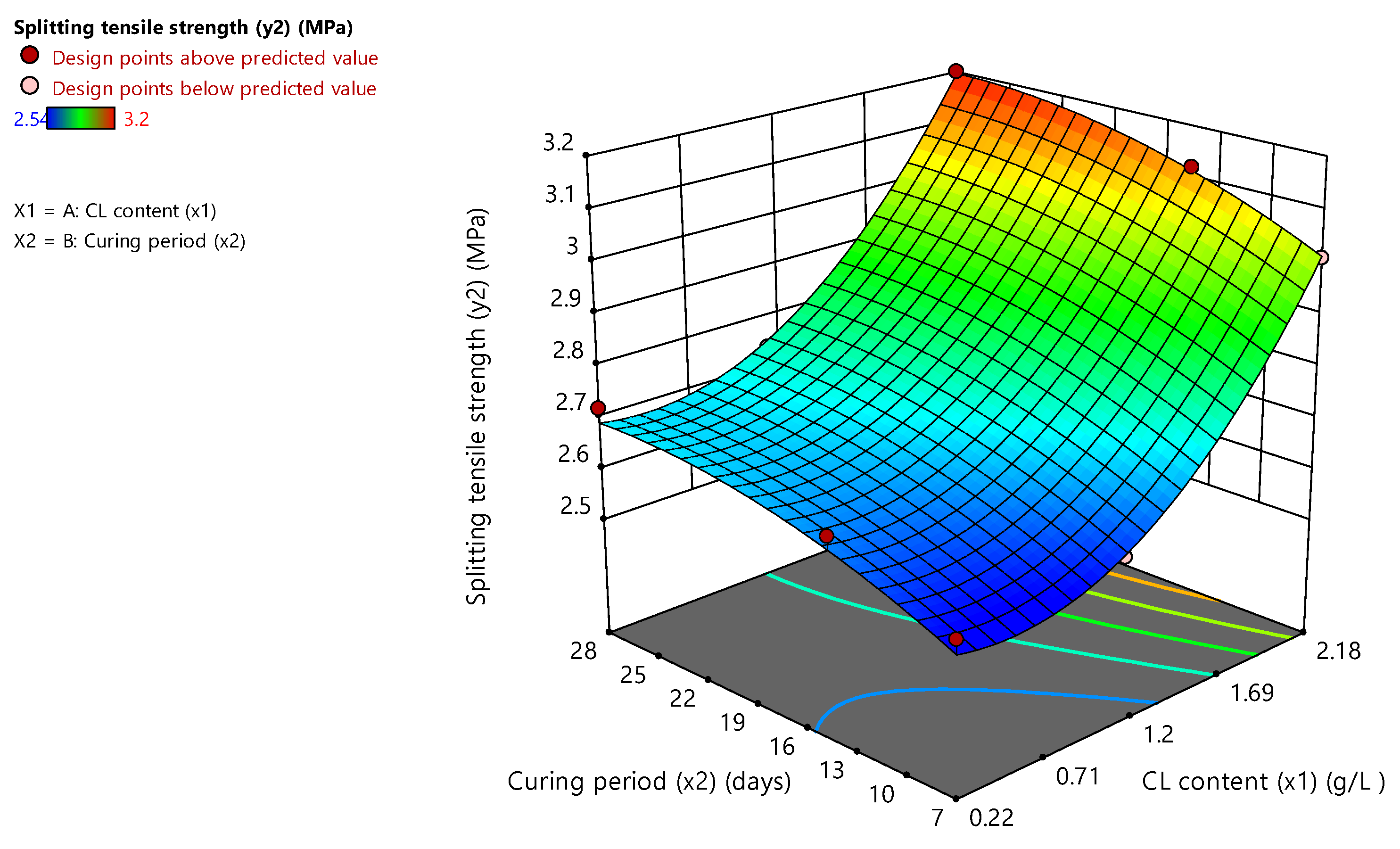
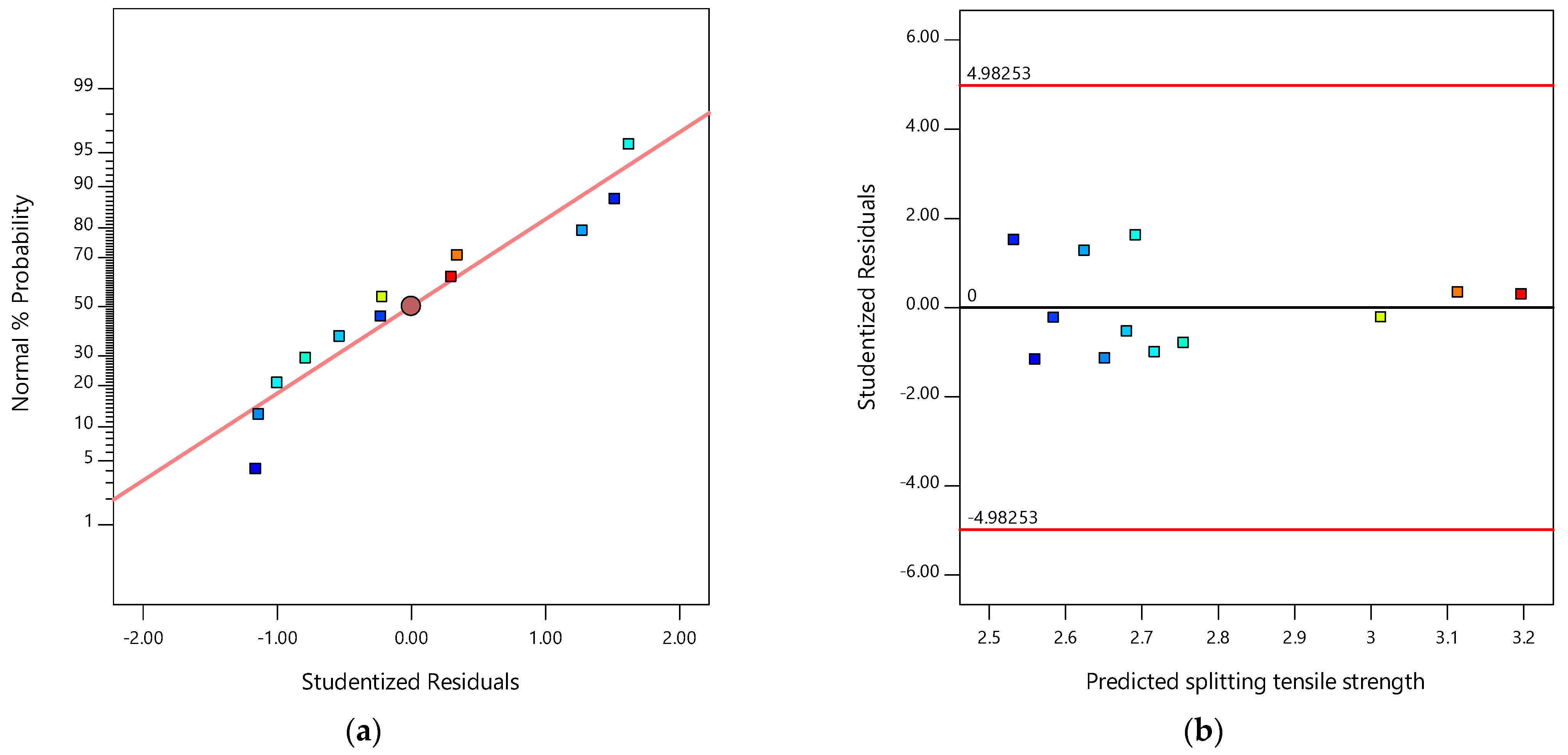
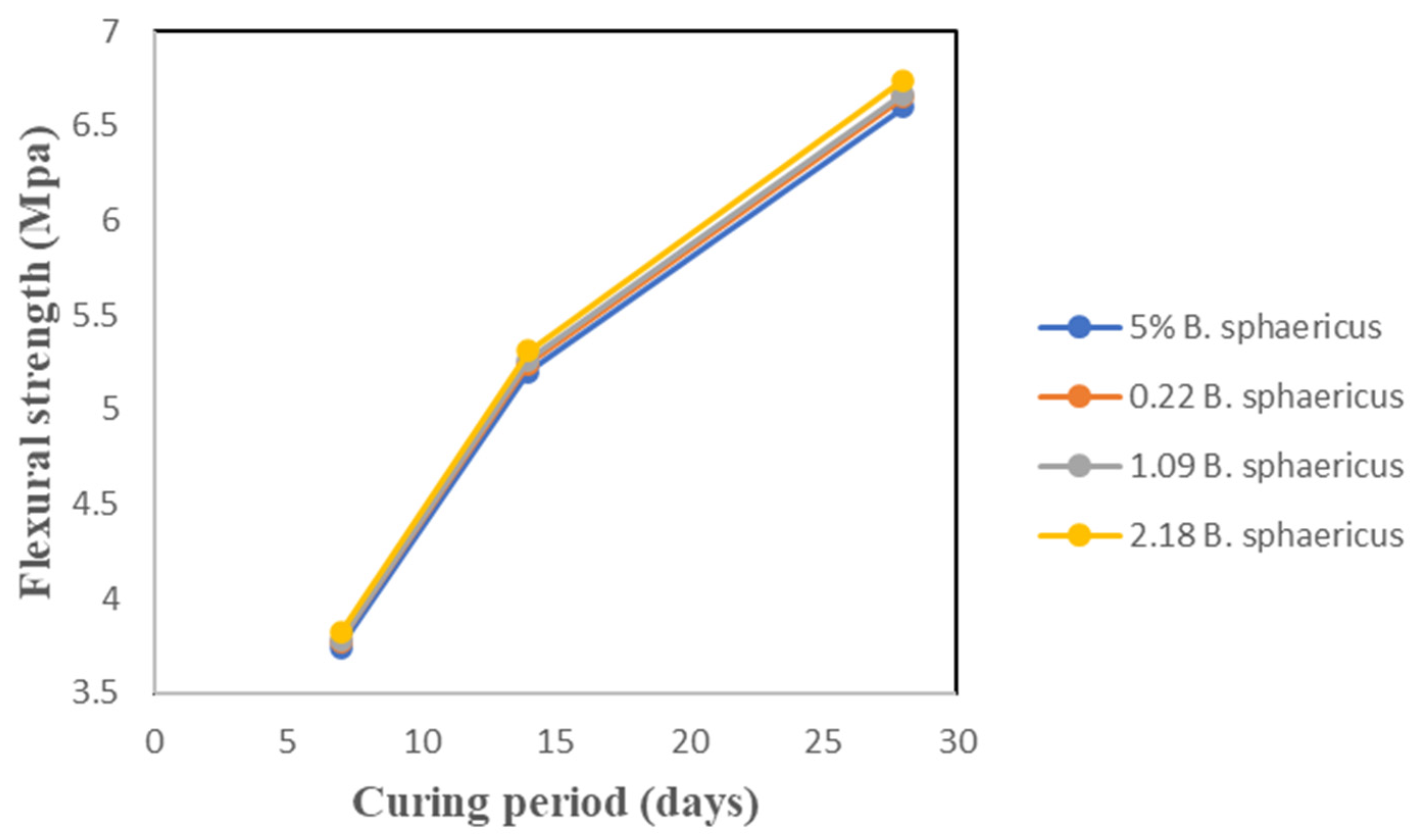


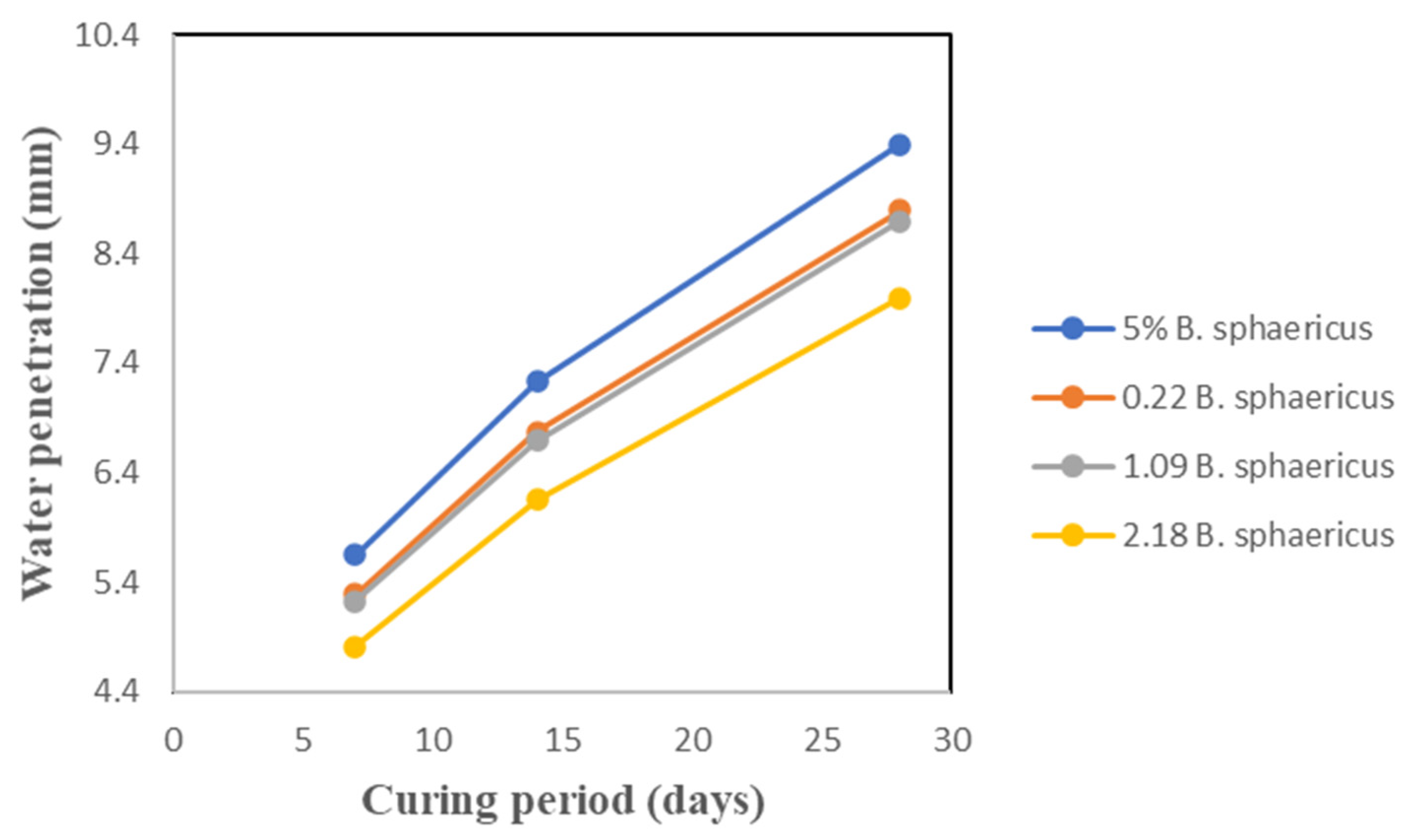

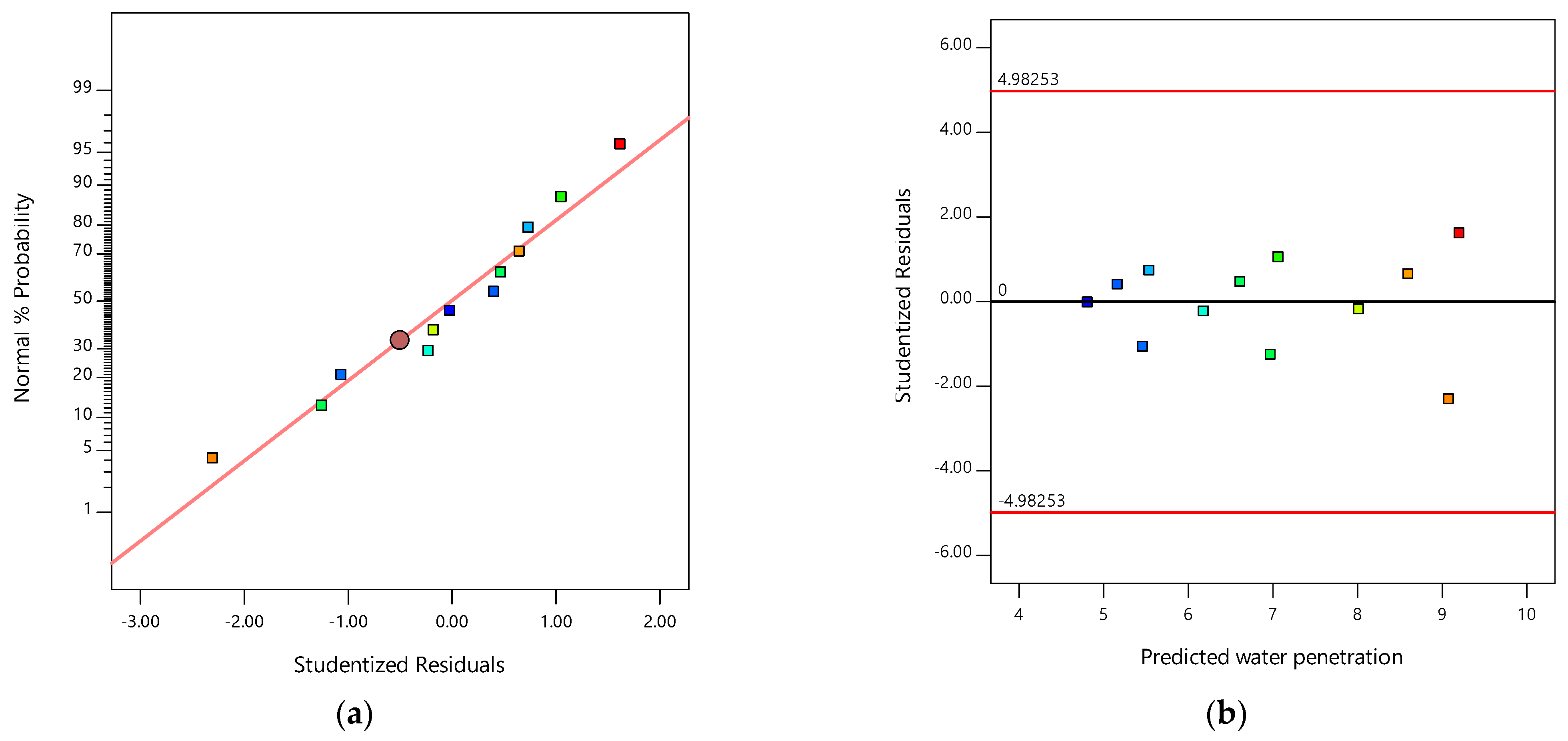
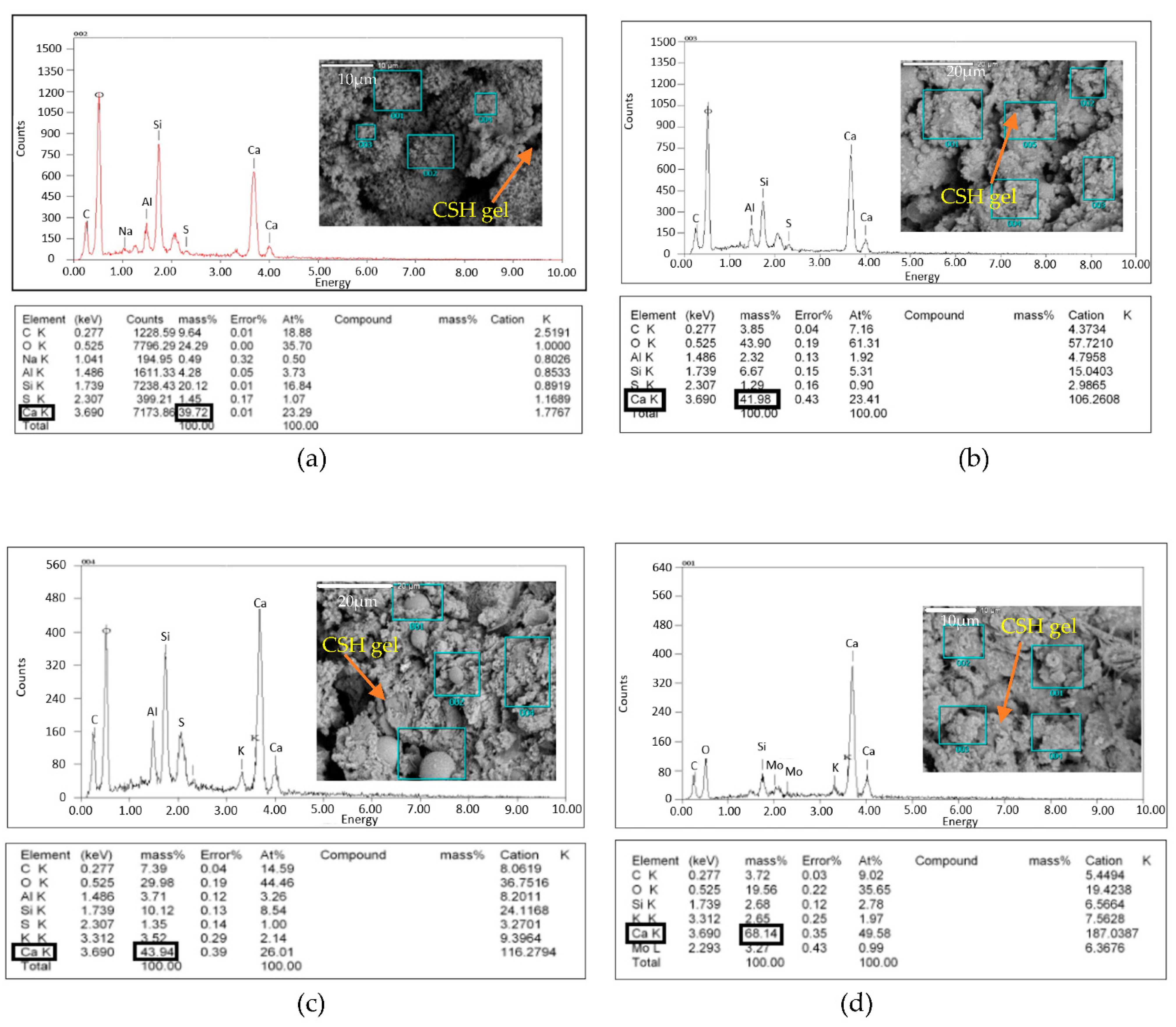
| Chemical Formula of Calcium Lactate | C6H10CaO6 | Weight of Calcium Lactate Used Based on Water (34.2 kg) |
|---|---|---|
| Molar mass of calcium lactate | 218 g/mol | - |
| 0.001 mol/L × 218 g/mol | 0.22 g/L | 7.5 g |
| 0.005 mol/L × 218 g/mol | 1.09 g/L | 37.3 g |
| 0.01 mol/L × 218 g/mol | 2.18 g/L | 74.6 g |
| Batch No. | Specimens | Cement (kg) | Fine Aggregate (kg) | Coarse Aggregate (kg) | Water (L) | Bacteria in Nutrient Broth (L) | Calcium Lactate (g) |
|---|---|---|---|---|---|---|---|
| 1 | 5% B. sphaericus | 63 | 111.6 | 183 | 32.5 | 1.71 | - |
| 2 | 0.22 B. sphaericus | 63 | 111.6 | 183 | 32.5 | 1.71 | 7.5 |
| 3 | 1.09 B. sphaericus | 63 | 111.6 | 183 | 32.5 | 1.71 | 37.3 |
| 4 | 2.18 B. sphaericus | 63 | 111.6 | 183 | 32.5 | 1.71 | 74.6 |
| Run | ||||||||||
|---|---|---|---|---|---|---|---|---|---|---|
| Experiment | Prediction | Experiment | Prediction | Experiment | Prediction | Experiment | Prediction | |||
| 1 | 0 | 7 | 26.40 | 26.60 | 2.54 | 2.56 | 3.74 | 3.75 | 5.65 | 5.54 |
| 2 | 0.22 | 7 | 26.60 | 26.79 | 2.56 | 2.53 | 3.77 | 3.76 | 5.29 | 5.46 |
| 3 | 1.09 | 7 | 28.60 | 27.75 | 2.58 | 2.58 | 3.78 | 3.79 | 5.23 | 5.17 |
| 4 | 2.18 | 7 | 28.90 | 29.36 | 3.01 | 3.01 | 3.82 | 3.82 | 4.81 | 4.81 |
| 5 | 0 | 14 | 33.10 | 32.86 | 2.63 | 2.65 | 5.20 | 5.22 | 7.23 | 7.07 |
| 6 | 0.22 | 14 | 33.20 | 33.17 | 2.65 | 2.62 | 5.24 | 5.23 | 6.77 | 6.97 |
| 7 | 1.09 | 14 | 33.90 | 34.59 | 2.67 | 2.68 | 5.26 | 5.26 | 6.69 | 6.62 |
| 8 | 2.18 | 14 | 37.20 | 36.78 | 3.12 | 3.11 | 5.31 | 5.31 | 6.15 | 6.19 |
| 9 | 0 | 28 | 38.20 | 39.03 | 2.70 | 2.72 | 6.60 | 6.61 | 9.40 | 9.20 |
| 10 | 0.22 | 28 | 40.84 | 39.58 | 2.72 | 2.69 | 6.65 | 6.63 | 8.80 | 9.08 |
| 11 | 1.09 | 28 | 41.37 | 41.93 | 2.74 | 2.75 | 6.67 | 6.68 | 8.70 | 8.60 |
| 12 | 2.18 | 28 | 45.41 | 45.28 | 3.20 | 3.20 | 6.74 | 6.74 | 8.00 | 8.02 |
| Term | Coefficient | F Value | p Value |
|---|---|---|---|
| Model | 37.45 | 116.73 | <0.0001 |
| 2.07 | 46.98 | 0.0005 | |
| 7.18 | 500.64 | <0.0001 | |
| 0.7859 | 5.44 | 0.0585 | |
| 0.1849 | 0.1451 | 0.7164 | |
| −2.38 | 15.94 | 0.0072 |
| Term | Coefficient | F Value | p Value |
|---|---|---|---|
| Model | 2.74 | 175.04 | <0.0001 |
| 0.2464 | 773.37 | <0.0001 | |
| 0.0858 | 82.80 | <0.0001 | |
| 0.0061 | 0.3749 | 0.5628 | |
| 0.1634 | 131.22 | <0.0001 | |
| −0.0441 | 6.33 | 0.0455 |
| Term | Coefficient | F Value | p Value |
|---|---|---|---|
| Model | 5.81 | 12,833.29 | <0.0001 |
| 0.0441 | 59.45 | 0.0002 | |
| 1.45 | 56,490.15 | <0.0001 | |
| 0.0115 | 3.23 | 0.1222 | |
| −0.0020 | 0.0453 | 0.8385 | |
| −0.5766 | 2595.72 | <0.0001 |
| Term | Coefficient | F Value | p Value |
|---|---|---|---|
| Model | 7.18 | 126.06 | <0.0001 |
| −0.4288 | 35.23 | 0.0010 | |
| 1.71 | 492.54 | <0.0001 | |
| −0.1037 | 1.65 | 0.2462 | |
| 0.0079 | 0.0046 | 0.9484 | |
| −0.3431 | 5.78 | 0.0531 |
| Run | ||||||||||
|---|---|---|---|---|---|---|---|---|---|---|
| Actual | Predicted | Actual | Predicted | Actual | Predicted | Actual | Predicted | |||
| 1 | 2.18 | 23.42 | 43.51 | 43.43 | 3.19 | 3.19 | 6.93 | 6.50 | 7.55 | 7.55 |
| Specimen | Ca Mass (%) |
|---|---|
| 0 B. sphaericus | 39.72 |
| 0.22 B. sphaericus | 41.98 |
| 1.09 B. sphaericus | 43.94 |
| 2.18 B. sphaericus | 68.14 |
Publisher’s Note: MDPI stays neutral with regard to jurisdictional claims in published maps and institutional affiliations. |
© 2021 by the authors. Licensee MDPI, Basel, Switzerland. This article is an open access article distributed under the terms and conditions of the Creative Commons Attribution (CC BY) license (https://creativecommons.org/licenses/by/4.0/).
Share and Cite
Abo Sabah, S.H.; Anneza, L.H.; Juki, M.I.; Alabduljabbar, H.; Othman, N.; Al-Gheethi, A.A.; Al-Shalif, A.F. The Use of Calcium Lactate to Enhance the Durability and Engineering Properties of Bioconcrete. Sustainability 2021, 13, 9269. https://doi.org/10.3390/su13169269
Abo Sabah SH, Anneza LH, Juki MI, Alabduljabbar H, Othman N, Al-Gheethi AA, Al-Shalif AF. The Use of Calcium Lactate to Enhance the Durability and Engineering Properties of Bioconcrete. Sustainability. 2021; 13(16):9269. https://doi.org/10.3390/su13169269
Chicago/Turabian StyleAbo Sabah, Saddam Hussein, Luis Hii Anneza, Mohd Irwan Juki, Hisham Alabduljabbar, Norzila Othman, Adel Ali Al-Gheethi, and Abdullah Faisal Al-Shalif. 2021. "The Use of Calcium Lactate to Enhance the Durability and Engineering Properties of Bioconcrete" Sustainability 13, no. 16: 9269. https://doi.org/10.3390/su13169269
APA StyleAbo Sabah, S. H., Anneza, L. H., Juki, M. I., Alabduljabbar, H., Othman, N., Al-Gheethi, A. A., & Al-Shalif, A. F. (2021). The Use of Calcium Lactate to Enhance the Durability and Engineering Properties of Bioconcrete. Sustainability, 13(16), 9269. https://doi.org/10.3390/su13169269








